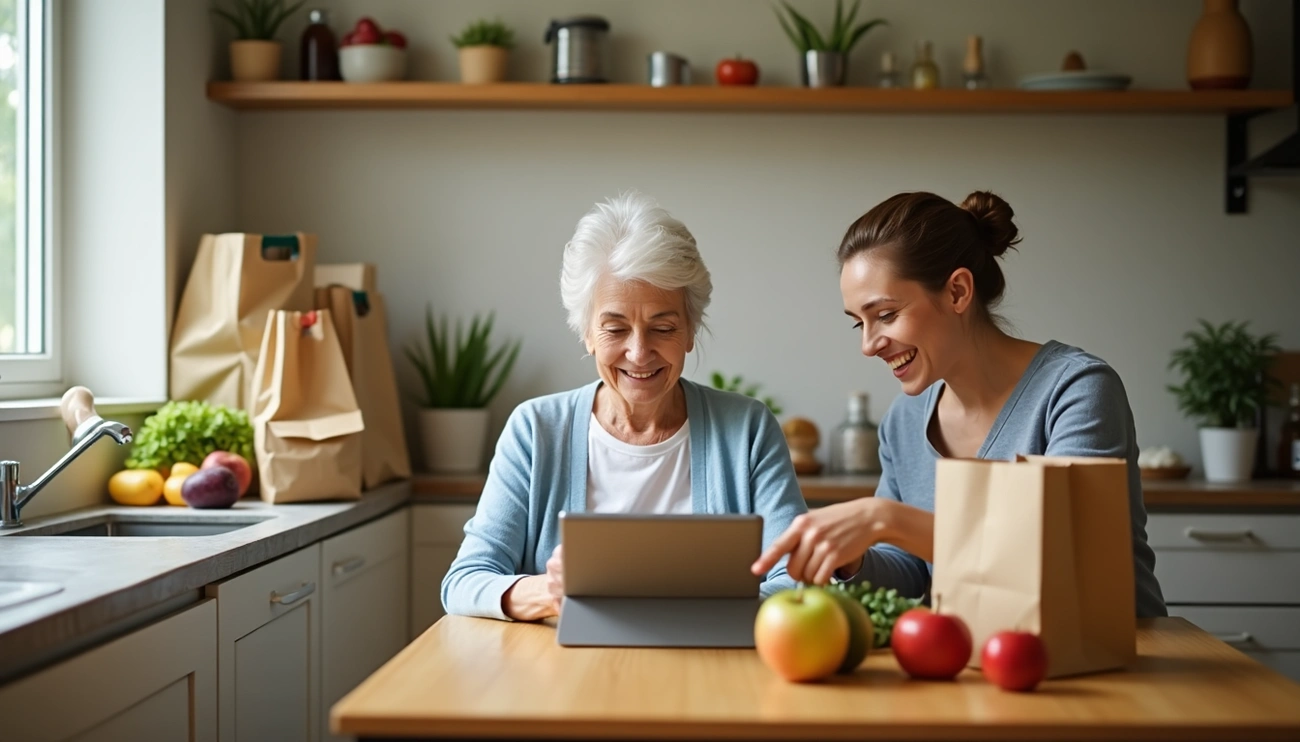Did you know that elderly grocery delivery services are becoming a saving grace for seniors with limited mobility? Our advisors help 300,000 families each year find the right senior care for their loved ones, and grocery delivery is increasingly part of that support system.
For many older adults, grocery store trips can be physically demanding. They involve substantial walking, bending down, and lifting—tasks that seniors and people with mobility challenges often struggle to perform independently. However, thanks to grocery delivery services for seniors, essential items are now accessible without the physical strain.
We understand that maintaining independence is crucial as we age. That’s why grocery shopping services for seniors have become such a compassionate solution. Instacart, for example, offers a dedicated senior support service for shoppers over age 60, assisting with creating accounts and placing orders. Furthermore, they partner with numerous local retailers including Kroger, Target, Costco, Whole Foods, and many others.
In this simple guide, we’ll walk you through setting up grocery delivery for elderly family members, explore the best options available, and share practical tips to make the experience as smooth as possible.
Understanding Grocery Delivery for Seniors
Grocery shopping becomes increasingly difficult as we age. Studies show that grocery delivery is especially beneficial for seniors with mobility issues, compromised immune systems, or those who have difficulty navigating stores. Let me explain why these services have become essential for older adults.
Why grocery delivery matters for older adults
For many seniors, grocery shopping ranks among the most challenging daily activities. Research indicates that shopping difficulty increases with age, physical impairment, and the number of comorbid conditions. Grocery delivery eliminates the need to navigate crowded aisles, stand in long lines, and carry heavy bags. Additionally, these services have become particularly valuable during times when staying home is crucial for health and well-being.
Common challenges with in-store shopping
In-store shopping presents numerous obstacles for seniors:
- Physical demands: Arthritis makes it difficult to move quickly, bend over to reach products, or maneuver carts
- Sensory limitations: Age-related vision and hearing loss affect product recognition and communication with staff
- Safety concerns: 40% of caregivers worry about potential illness exposure when shopping with loved ones
- Transportation issues: Many seniors rely on others for rides to stores, with 18% of urban older adults having someone else drive them
Seniors often face challenges with technology in stores as well, with studies showing older consumers have scarce interactions with in-store technologies.
For Seniors
Groceries & Rides Services
Screened & monitored services from Uber, DoorDash, Instacart and more, with or without a smartphone, 24/7.
Millions of requests fulfilled for hundreds of thousands of people living independently at home. Available in all 50 states, Canada, and Australia.
How delivery services help maintain independence
Elderly grocery delivery services empower seniors to maintain their independence by allowing them to shop without relying on others for transportation or assistance. Consequently, they can continue making choices about their food preferences while staying self-reliant.
A significant benefit is access to fresh, healthy food—essential for seniors’ well-being. In fact, consistent access to nutritious food helps older adults manage chronic conditions and improve overall health.
Grocery delivery also reduces exposure to outdoor hazards such as bad weather or crowded spaces. Notably, 50% of older Americans use grocery delivery once a month or less, while visiting physical stores at least once a week, suggesting there’s still room for growth in this valuable service.
How to Set Up a Grocery Delivery Service
Setting up grocery delivery is straightforward once you understand the basic steps. Many elderly grocery delivery services offer intuitive interfaces designed with seniors in mind. Let me walk you through the process:
1. Choose a delivery platform
Initially, you’ll need to select a service that delivers in your area. Popular options include:
- Instacart (partners with stores like Kroger, Target, Costco, Whole Foods)
- Walmart Grocery (offers everyday low prices with fast service)
- Amazon Fresh (accessible through your Amazon account)
- Shipt (annual fees among the lowest at $99 per year)
- FreshDirect (requires subscription starting at $79 for 6 months)
Some services like GoGoGrandparent allow ordering through a simple phone call instead of using an app or website.
2. Create an account or get help setting one up
To register, you’ll need to provide basic information including your name, address, and payment method. Most platforms offer multiple sign-in options – Instacart and Shipt allow login through Google or Facebook accounts. If technology feels overwhelming, ask a family member for assistance or use services with dedicated senior support.
3. Add items to your cart
Thereafter, browse items by:
- Searching directly for specific products
- Exploring by department categories
- Checking recommended items based on previous purchases
Add notes for specific preferences—like ripeness level for produce or substitution instructions if items are unavailable.
4. Enter delivery and contact details
Next, provide your complete address, including any access codes or building numbers. Select a delivery window that works for you—some services offer same-day delivery. Specify any special delivery instructions, such as “leave at door”.
5. Place your order and track delivery
Finally, review your cart before checking out. Minimum orders typically start around $30-$35 for free delivery. After placing your order, many services offer real-time tracking so you know exactly when your groceries will arrive. Services like Instacart even allow communication with your shopper during the process.
Popular Grocery Delivery Services for the Elderly
Several grocery delivery platforms offer features tailored specifically for older adults. These services vary in pricing, availability, and senior-focused features.
Instacart
Instacart stands out among grocery delivery services for seniors with its dedicated Senior Support Service for shoppers over 60. This team assists with account creation and order placement for those needing extra help. Instacart partners with numerous retailers including Kroger, Target, Costco, and Whole Foods, providing extensive product options. Orders typically arrive within 1-2 hours, making it ideal for urgent needs. Delivery fees start at $3.99 for orders over $35, or you can opt for an Instacart+ membership at $99 annually for unlimited free delivery.
Amazon Fresh
Amazon Fresh offers same-day or scheduled grocery delivery primarily to Prime members. Notably, Prime membership costs $139 annually or $14.99 monthly, with discounts available for EBT or Medicaid cardholders. Amazon Fresh delivers from their own warehouses and Whole Foods, packaging items in temperature-controlled bags when necessary. Prime members receive free two-hour delivery on orders above $35. Moreover, their user-friendly interface makes reordering previous purchases straightforward, a feature particularly valuable for elderly individuals who buy similar items regularly.
Walmart Grocery
Walmart has enhanced accessibility by integrating with senior-care applications like Avanlee Care. Accordingly, caregivers can place grocery orders for delivery or pickup through these specialized platforms. Walmart’s “Walmart+ Assist” program offers membership at half-price ($49 annually or $6.47 monthly) for recipients of government assistance programs like Medicaid and SNAP. Benefits include free delivery, gas savings, and other perks that assist budget-conscious seniors.
Shipt
Shipt delivers from various grocery stores and pharmacies like CVS. Their annual membership costs $99, making it one of the more affordable options with free delivery on orders over $35. Essentially, what distinguishes Shipt is its shopper communication feature—users can text their personal shoppers directly with specific instructions or requests, particularly beneficial for seniors with dietary restrictions. Furthermore, Shipt has partnered with healthcare providers to offer free grocery delivery to eligible Medicare Advantage members.
FreshDirect
FreshDirect primarily serves the East Coast, including New York City, New Jersey, and Washington D.C. areas. Their service combines grocery delivery with prepared meals, making it valuable for seniors who alternate between cooking and ready-made options. Delivery fees vary by location, though they offer a DeliveryPass membership for regular users. FreshDirect uniquely allows customers to select delivery times within a 3-hour window, beneficial for caregivers who need scheduling flexibility.
Benefits and Tips for a Smooth Experience
The advantages of elderly grocery delivery extend far beyond simple convenience. Primarily designed to enhance quality of life, these services offer practical solutions to common challenges faced by older adults.
Improved safety and reduced physical strain
Safety remains the top priority for seniors using grocery delivery. These services eliminate the need to navigate hazardous conditions like slippery parking lots or uneven store terrain. Indeed, staying home significantly reduces fall risks associated with shopping activities such as pushing heavy carts, reaching for items, or carrying bags. Given that mobility limitations make traditional shopping potentially dangerous, delivery services provide a safer alternative.
Same-day delivery and real-time tracking
Many grocery delivery services for seniors now offer same-day delivery options, ensuring fresh food is readily accessible. With real-time tracking features, seniors know exactly when their orders will arrive, reducing uncertainty. As an illustration, GoGoGrandparent’s dedicated “GoGoGuardians” track every order and maintain communication with personal shoppers throughout the process.
Tips for managing substitutions and preferences
When using grocery shopping services for seniors:
- Specify alternative items in case your selections are unavailable
- Add detailed notes about preferences (like ripeness level for produce)
- Request refunds rather than substitutions when preferred
- Use services that allow direct communication with shoppers
Above all, remember that many platforms enable you to review items before finalizing your order, reducing surprises.
How caregivers can assist with orders
Family members or caregivers play valuable roles in the grocery delivery for elderly relatives. They can help create shopping lists, especially important for seniors with vision difficulties. Furthermore, caregivers can check delivered items for quality and expiration dates, ensuring safety and satisfaction.
For recurring needs, caregivers can set up standing orders—particularly useful when managing grocery delivery service for elderly family members who live independently. In addition to this, some services like GoGoGrandparent allow caregivers to place orders on behalf of seniors through a simple phone call rather than requiring app usage.
Conclusion
Grocery delivery services have transformed the way seniors manage their essential shopping needs. Above all, these services provide independence and dignity while eliminating physical challenges that many older adults face in traditional stores. Through platforms like Instacart with its dedicated Senior Support Service or phone-based options like GoGoGrandparent, technology barriers no longer prevent access to fresh, nutritious food.
Additionally, the variety of available services means seniors can find options matching their specific needs and budgets. Whether someone prefers Amazon Fresh’s user-friendly interface or Walmart’s discounted membership through assistance programs, choices abound for every situation and preference.
The benefits extend far beyond convenience. Consequently, seniors experience improved safety, reduced physical strain, and greater peace of mind. Family members also gain reassurance knowing their loved ones can maintain independence without risking falls or other shopping-related hazards.
Setting up these services might seem daunting at first, but the process becomes straightforward with proper guidance. Many platforms offer senior-specific support, and caregivers can provide valuable assistance with account creation and order management when needed.
Finally, grocery delivery represents more than just a modern convenience—it’s a meaningful solution that helps seniors age in place with dignity. The ability to choose one’s own food remains fundamental to independence, and these services make that possible even when mobility becomes limited. Therefore, exploring grocery delivery options could significantly improve quality of life for the seniors in your life.
FAQs
Q1. What are the best grocery delivery services for seniors? Popular options include Instacart, Amazon Fresh, Walmart Grocery, Shipt, and FreshDirect. Each offers unique features tailored to seniors’ needs, such as user-friendly interfaces, dedicated support, and flexible delivery options.
Q2. How can seniors set up grocery delivery services? To set up grocery delivery, seniors should choose a platform, create an account (or get help setting one up), add items to their cart, enter delivery details, and place the order. Many services offer assistance specifically for older adults who may need extra help.
Q3. Are there any cost-saving options for seniors using grocery delivery services? Yes, some services offer discounts for seniors. For example, Walmart+ Assist provides half-price memberships for recipients of government assistance programs. Additionally, many platforms offer free delivery on orders above a certain amount.
Q4. How can caregivers assist seniors with grocery delivery? Caregivers can help create shopping lists, set up accounts, place orders on behalf of seniors, and check delivered items for quality and expiration dates. Some services even allow caregivers to manage orders through phone calls rather than apps.
Q5. What are the main benefits of grocery delivery for seniors? Grocery delivery services offer improved safety by reducing fall risks, provide independence in food choices, ensure access to fresh and healthy food, and reduce physical strain associated with traditional shopping. They also offer convenience through features like same-day delivery and real-time order tracking.




